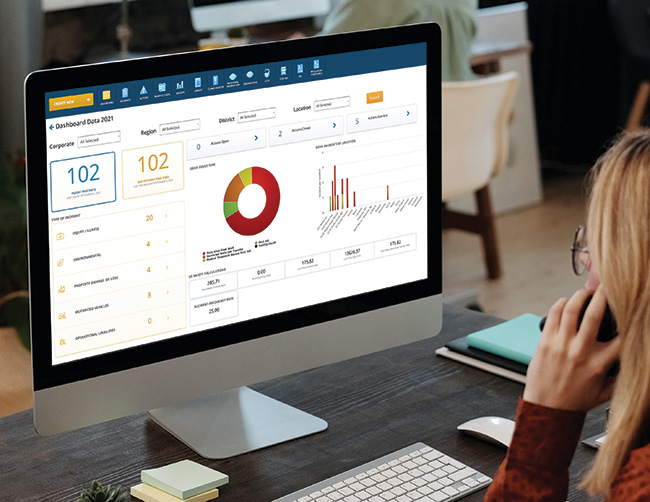If your Safety Observations are not saving you money, you are not conducting them as efficiently as you should be.
By Caroline Sharpless and Christien Ducker
Most people view compliance as a costly, yet unavoidable, expense. This is partially true—there is no escaping compliance—but that does not mean it needs to be the cause of financial hemorrhage. With the right tools, safety and compliance can be a bottleneck for revenue growth. The average U.S. company spends around $10k per employee per year on compliance.
The key to lowering these costs is identifying potential safety hazards before accidents or inspections occur. Conducting internal safety observations is the best way to practice preventative compliance; however, in order for them to be effective, they need to be implemented in an organized, efficient, and thoughtful way.

Photos courtesy of Safety Management Systems.
Digitize Your Safety Observations
In theory, Safety Observations are internal checks conducted by supervisors to track safe and unsafe practices in your workplace. They are key in capturing operational pitfalls or bumps in employee performance. This
information allows supervisors to make the necessary adjustments to stop an accident or prevent fines before they happen.
The problem is that many companies conduct these Safety Observations using paper forms and after the inspection, never look at them again. The fear of a surprise observation is an effective way to motivate your employees to behave when no one is watching, but the benefits do not need to end there. For decades, people built the habit of collecting data through paper-based forms and filing them away in a cabinet where the data wastes away until it becomes obsolete.
A pre-emptive, health safety and fleet compliance software solution enables workers to record the risk, identify the cause, report the outcome, analyze the data, adjust processes, and eliminate the risk.
Look for Patterns in the Data
Eliminating paper-based processes is the first step, but the same issues can still come up if you do not take advantage of the technology. If you let your digital system turn into a digital file cabinet, the same issues will come up. Without proper analysis, there is no growth.
If you want your compliance costs to go down, the purpose of Safety Observations should not be to get employees in trouble—it should be to identify trends. A safety management system allows users to run reports that aggregate the data to show you key insights across all areas of safety. Collect hundreds of data points related to driver behavior, vehicle health, and facility safety—then see where the problems lie. Is one location performing worse than another? If so, what factors make that location different from the others? Collect driver behavior information such as speed of travel, start from traffic signals, passing techniques, turn speeds, signal usage, seatbelt usage, following distance, backing techniques, and more. Collect facility data such as cleanliness, fire extinguisher functionality, first aid availability, etc.
Data is only as good as the data points you are collecting and what you do with them afterwards. Finding commonalities in data used to take days or weeks of sorting through forms or spreadsheets. Now, you can run these sorts of reports with the click of a button.

submitted, they are automatically uploaded onto the online database so
management can see them.
Find the Risk Behind the Numbers
There needs to be a constant variable to identify discrepancies in data. If your Safety Observation efforts are limited to a random inspection once a month, you are not taking advantage of your full potential. Add in a constant, and you will pick up on patterns. For example, if you conduct repeated observations with multiple drivers at separate times during the day, you might find that one driver speeds more than the rest. However, if you conduct all of the observations at the same time, you might find all of the drivers speeding. Drivers tend to drive faster at night.
This will show you that the driver is not the problem, but rather night speeding is. Once you have this information, you can take measures to treat the problem before a costly accident occurs. Some
clients realized there were holes in their training. Others noticed a concentration in issues with older employees, which made them realize employees who had been with the company past a certain amount of time needed to be retrained.
These data points can help you create new algorithms and raise flags on new issues. You can also use them to judge whether the observations themselves are working. If one supervisor is consistently submitting flawless observations, the issue might be the inspector. A Safety Observation should never come back 100 percent clear. If so, the supervisor is not doing their job properly. We are all human and there is always room for improvement.

An Essential Investment
The solutions to these problems should always go further than pointing the finger at employees. Employee behavior is fueled by management. Data is what tells you how to prevent other employees from repeating the same mistakes. Improving a company’s safety culture is a daunting task made easier when you have specific places to start. Time is money, and many company leaders do not realize putting time into preventative compliance tactics can be an investment. The reality is that when implemented correctly, Safety Observations and predictive analysis efforts are an incredibly effective method of improving compliance and decreasing the steep costs, in addition to other risks that could lead to loss of production and harm to employees and the environment. | WA
Caroline Sharpless is Director of Marketing for SMS360, an EHS software platform that digitizes regulatory compliance and safety management. The team behind SMS360 has decades of experience in the waste industry and safety sphere. Companies across the globe use SMS360 to identify costly risk, operational inefficiencies, and compliance pitfalls.
Christien Ducker is CEO and Founder of Safety Management Systems, Inc. She started SMS360 after successfully launching two UK EHS platforms into the North American Market. She was struck by the lack of affordable systems for small companies who suffer the highest risk both in number of incidents and fines. In 2016, SMS360’s first client was a small waste company from the Bronx who have since become one of the fastest growing waste companies in the Northeast. Her vision was to provide an affordable, scalable, modular, multi-lingual and mobile-capable platform that both small and large companies can use.
For more information, call (203) 838-8877 or e-mail [email protected]
